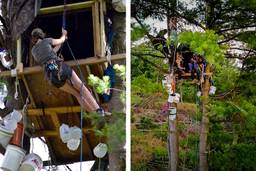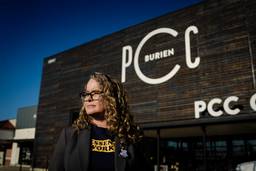We Can’t Confront Fascism Without Addressing White Settler Colonialism
Why Indigenous resistance is central to the fight against white supremacy.
Jen Deerinwater

The white supremacists didn’t come to Washington, D.C. on August 12. They were already here, occupying the White House, capitol, Supreme Court and federal agencies. The white invasion brought white supremacy to Turtle Island, and people indigenous to this land have been suffering from it for more than 500 years. Washington, D.C. is the colonizer’s capital — and the scourge of settler colonialism, and the racism and other ills it brought here, haven’t been addressed by those in power.
On August 12, 2017, white supremacist Jason Kessler’s “Unite the Right” rally in Charlottesville, Virginia turned violent and left many injured and one anti-racist activist, Heather Heyer, dead. Over 300 white supremacists marched with torches and surrounded students at the University of Virginia to oppose the removal of a confederate monument. The violence that was so blatantly on display last year led the city of Charlottesville to deny Kessler permits for his follow-up rally. Kessler filed suit against the city, but eventually dropped the charges to focus on his rally in Washington, D.C.
The “Unite the Right 2” rally took place with dismal numbers of approximately 30 people aligned with Kessler. Police, journalists and counter-protesters far outnumbered the white nationalists who failed to follow their own rally and march schedule. Kessler and crew arrived in Washington, D.C. earlier than expected and closed their rally 30 minutes before it was even scheduled to begin.
The rally was held in Lafayette Park where a statue of Andrew Jackson stands. Jackson was a slave owner who murdered thousands of Natives. He used our skin for bridle reins and is best known for ordering the forced removals of southeastern tribes to then-Indian Territory, now present-day Oklahoma. It’s fitting that Kessler’s rally took place next to this statue and directly across the White House that sits on stolen Piscataway land that was built by African slaves.
The colonizer’s capital
At a press conference on August 9, that was lacking Native representation, Washington, D.C. Mayor Muriel Bowser stated, “We have people coming to our city for the sole purpose of spewing hate. … We the people of Washington, D.C. unequivocally denounce hate, we denounce anti-semitism, we denounce the rhetoric we expect to hear this Sunday.” Bowser also went on to say that the District hosts billions of visitors every year who come, among other things, to visit the monuments.
The cognitive dissonance of Bower’s statement is hard to miss. The monuments, such as the Jackson statue, are a nod of glory to Native-murdering founding fathers and generals. The colonizer’s capital sits on Piscataway land that was seized through broken treaties and Native genocide, a genocide that is celebrated everyday in the capital through the use of Native mascots.
Washington, D.C. is home to the racist R*dskins football team. Many District employees wear R*dskins paraphernalia while on the clock and have their work stations covered in this anti-Native hate speech. Meanwhile, the District does not directly devote any agencies to serving the local Native population. If one’s knowledge of Natives were based on the treatment we receive in Washington, D.C., one would be left to believe we’re all dead and nothing more than garish red, foolish cartoons giving rain dances and war cries for the entertainment of the non-Native gaze. The mayor’s office was unavailable for comment.
Washington, D.C. is home to roughly 40 law enforcement agencies, including federal and military law enforcement. During the press conference, Metropolitan Police Department (MPD) Chief Peter Newsham stated that law enforcement’s goal to prevent violence was “to keep the two groups separate.” This statement implied that any violence wouldn’t be a result of the violence that white supremacists — or police officers — bring to Washington, D.C., effectively shifting blame for potential problems on counter-protesters. Newsham’s statement that “we’re not about violence in Washington, D.C.,” is deeply ironic, given the violence the MPD unleashed on J20 protesters.
Newsham also said that property destruction would not be tolerated and that law enforcement’s “number-one role is to make sure nothing gets broken, and nobody gets hurt.” The fact that “nobody gets hurt” was the secondary goal is important.
But there was one group that law enforcement kept safe: Kessler and his group of white supremacists were given special law enforcement escorts with private train cars from Virginia to a Washington, D.C. train station next to a major hospital.
The MPD behaves with such callousness that, while I was covering this story on August 12, an MPD officer came within a foot of hitting me while he drove his motorcycle onto the sidewalk, unannounced. A friend yelled just in time for me to move. MPD and other law enforcement agencies were out in full force across downtown Washington, D.C. that day, constituting an intimidating and unhelpful presence, to say the least, especially for marginalized communities that experience high rates of police violence.
The violence of white supremacy
Law enforcement concern for private property and white supremacists over Native lives is just another day of settler colonialism. The Indigenous people of this land have suffered from white supremacy the longest, with the harshest outcomes on Turtle Island. Natives’ rates of higher education are the lowest in the nation. Only 17 percent of Natives have obtained an Associates degree or higher in 2016, compared to 54 percent for white students. Oglala County, South Dakota, home to the Pine Ridge Reservation, is one of the poorest counties in the United States, with a poverty rate of 40.7 percent.
Native women suffer the highest rates of violence of any racial group in the United States. According to the National Institute of Justice 2010 Findings From the National Intimate Partner and Sexual Violence Survey, more than one in three (39.8 percent) American Indian and Alaskan Native women have experienced violence in the last year and more than four in five (84.3 percent) have experienced violence in their lifetimes. More than one in two (56.1 percent) Native women have experienced sexual assault in their lifetime.
The vast majority of this violence is interracial, which is an anomaly in the United States. Ninety-six percent of Native women reported that their sexual assaults were interracial, whereas 91 percent of non-Hispanic white women reported their assaults were of the same race. The numbers for interracial attacks are similar for every type of violence that Indigenous women in the U.S. face: domestic violence, sexual trafficking, stalking and murder. On some reservations, Native women are murdered at 10 times the national average.
Natives die significantly younger than any other group in the United States, even in so-called third world countries. In 2014, the life expectancy of Natives in Oglala County was is 66.8 years — the lowest in the United States. As Indian Country Today has pointed out, this is lower than the life expectancy in Sudan (67.2), India (66.9), and Iraq (67.7). This disparity is due to a number of factors, including the poor quality of medical care we receive.
The only healthcare available to Native people living on reservations and tribal villages is Indian Health Services (IHS), a federal program that’s consistently rated as the worst healthcare provider in America. IHS is also grossly underfunded: In 2016, Congress allotted $4.8 billion for IHS, which amounted to approximately $1,297 per person. For comparison, each person incarcerated in the federal prison system receives an average of about $6,973 in healthcare each year. There also aren’t enough healthcare clinics or hospitals to serve reservations and tribal villages, which forces many people to travel hundreds of miles for specialized care or simply go without.
Urban Natives don’t fare much better. In Washington, D.C. there isn’t a single IHS facility and the lack of culturally competent care I’ve received as a patient has been so severe that I’ve been subjected to hate speech, offensive and intrusive questions regarding my Indigeneity, and refusal of care by non-Native practitioners.
Natives also fair the worst in the criminal legal system. We are more likely to be killed by police then any other ethnic group. Native men are admitted to prison at four times the rate of white men, and Native women are incarcerated at six times the rate of white women. Our youth don’t fair any better in the system. In Minnesota, Native girls are 18 times more likely to be incarcerated than white girls. Native youth are also given the worst punishments and placed in adult facilities at higher rates than other groups.
The hyper-erasure that we suffer from doesn’t exclude us from the violence of white supremacy. In fact, it keeps settler colonialism, and in turn, white supremacy, in place. The people and elected officials of Washington, D.C. have only added to our harm without the slightest recognition that they are benefiting from the widespread violence we have to navigate every day on our land.






